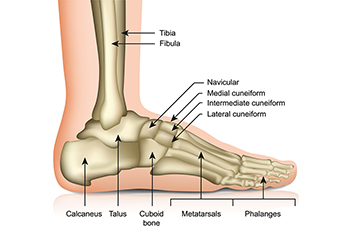Understanding Foot Anatomy
Tuesday, 14 January 2025 00:00
The human foot is a complex structure made up of 26 bones, 33 joints, and more than 100 muscles, tendons, and ligaments. These components work together to provide stability, flexibility, and mobility. The foot is divided into three main sections, which are the forefoot, midfoot, and hindfoot. The toes, or phalanges, and the metatarsals form the forefoot, while the midfoot contains the arches and bones that absorb shock. The hindfoot consists of the heel, or calcaneus, and ankle bones, providing support and balance. Muscles and tendons in the foot enable movement, from walking to running, while ligaments help to stabilize the joints. The arches of the foot, formed by the bones and supported by muscles and tendons, play a key role in shock absorption and weight distribution. Proper foot function is essential for overall mobility and posture. A podiatrist can help identify and treat conditions affecting the foot's bones, muscles, or joints. If you have a foot condition or foot pain, it is suggested that you schedule an appointment with a podiatrist.
If you have any concerns about your feet, contact Gregory T. Loo, DPM from Elite Podiatry. Our doctor can provide the care you need to keep you pain-free and on your feet.
Biomechanics in Podiatry
Podiatric biomechanics is a particular sector of specialty podiatry with licensed practitioners who are trained to diagnose and treat conditions affecting the foot, ankle and lower leg. Biomechanics deals with the forces that act against the body, causing an interference with the biological structures. It focuses on the movement of the ankle, the foot and the forces that interact with them.
A History of Biomechanics
- Biomechanics dates back to the BC era in Egypt where evidence of professional foot care has been recorded.
- In 1974, biomechanics gained a higher profile from the studies of Merton Root, who claimed that by changing or controlling the forces between the ankle and the foot, corrections or conditions could be implemented to gain strength and coordination in the area.
Modern technological improvements are based on past theories and therapeutic processes that provide a better understanding of podiatric concepts for biomechanics. Computers can provide accurate information about the forces and patterns of the feet and lower legs.
Understanding biomechanics of the feet can help improve and eliminate pain, stopping further stress to the foot.
If you have any questions please feel free to contact one of our offices located in Ahwatukee, and Phoenix, AZ . We offer the newest diagnostic and treatment technologies for all your foot and ankle needs.








